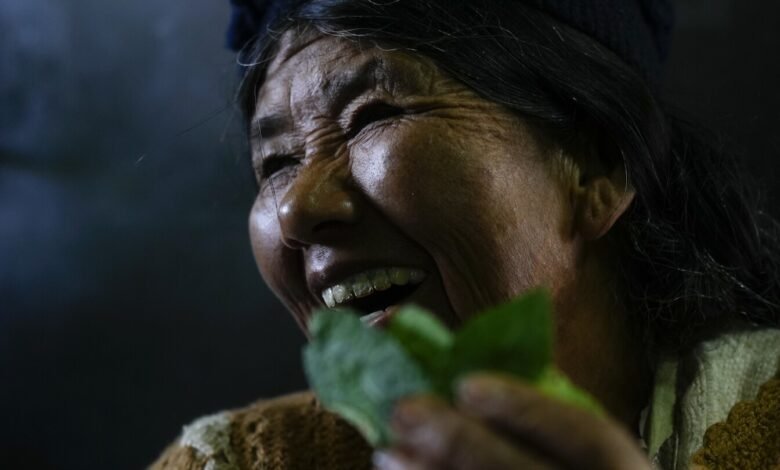An ancient coca blend is Bolivia’s new beer. But it’s not clear whether the world will accept

TRINIDAD PAMPA, Bolivia (AP) — If it were anywhere else in South America, the nondescript house with buckets of coca leaves soaked in liquid could be mistaken for a clandestine cocaine laboratory.
But this is La Paz, Bolivia, and the fruity aroma of coca macerating in barrels means you’ve arrived at the government-authorized El Viejo Roble distillery, which has been producing liquor from coca leaves for years and is now preparing to release a new coke-infused beer.
(AP Video/Carlos Guerrero)
It remains questionable whether Bolivia may persuade the world to accept the tough green leaf, best known across borders, as the main ingredient in cocaine. But a recent historic decision by the World Health Organization to study the non-narcotic benefits of coca has rekindled the old hopes of Bolivian farmers, manufacturers and sellers.
“Exporting is a desire that my people and I have had since we were children,” said Lizzette Torrez, leader of one of Bolivia’s main coca producer unions.
In Bolivia, the world’s third largest producer of coca leaves and cocaine, the ancient leaf has inspired spiritual rituals among Indigenous communities for generations – and, more recently, among the well-heeled, a deluge of coca-related products, including El Viejo Roble’s new $2 star drink.
Spiritual guide Julio Quispe wears coca leaves during the anniversary ceremony of the Ayllus and Markas del Qullasuyo National Council, a confederation of indigenous governing bodies, at the Plurinational Legislative Assembly, in La Paz, Bolivia, Wednesday, April 17, 2024. (AP Photo /Juan Karita)
“Beer can be bitter, but the sweet touch we give it with coke makes it more palatable,” said manager Adrián Álvarez of the distillery, where workers bottled the drink that will soon join vodka and flavored rum. of coca from El Viejo Roble. , old classics that they sell to the government and visitors.
The reach of Álvarez’s drinks, along with other coca-infused products, remains limited to artisanal markets in Bolivia and Peru, countries where the leaf is legal – as long as it is not used to make cocaine. As for the rest of the world, a United Nations Convention classifies coca leaf as a narcotic and imposes a general drug ban.
The Bolivian government is relaunching its decades-long effort to not only destigmatize the plant and make its export legal, but also to create a global market for coca liquor, soap, shampoo, toothpaste, baking flour and more. more. Their efforts received a major boost last fall when the WHO announced it would launch a scientific review of the coca leaf, the first step in a long process to decriminalize the leaf around the world.
A worker monitors bottles of coca leaf-flavored beer at the El Viejo Roble liqueurs assembly line in La Paz, Bolivia, Friday, May 3, 2024. (AP Photo/Juan Karita)
“The procedures were initiated for the first time in history,” Juan Carlos Alurralde, secretary general of the Bolivian vice presidency, told the AP. “The sheet will be seriously investigated.”
The last time the WHO carried out a study on the coca leaf was in 1992, but detailed results were never made public.
Employees from Colombia and Bolivia unveiled the research proposal together with WHO representatives in Vienna earlier this spring. They have until October, when a committee meeting on the study will begin in Geneva, to present research on the medicinal and nutritional properties of coca.
The study will also consider Bolivia’s efforts to commercialize coca, determining the maximum amount of cocaine alkaloid that coca products could contain on the world market.
“Experts have to assess whether this results in dependence,” said Alurralde.
Dionicio Limachi scatters coca leaves after removing them from a coca drying oven in Trinidad Pampa, a coca-producing area in Bolivia, Sunday, April 14, 2024. (AP Photo/Juan Karita)
A legal coca leaf market stands on a street corner in La Paz, Bolivia, Thursday, April 18, 2024. (AP Photo/Juan Karita)
Almost 80 kilometers north of La Paz, where high-altitude forest paints the hills of Trinidad Pampa green, coca producers, known as “cocaleros”, welcomed the news of the WHO review. For them, chewing coca leaves is a daily habit comparable to drinking coffee.
“This helps me harvest without getting tired and support my family,” said farmer Juan de Dios Cocarico, stuffing a packet of coca in his mouth as he ripped the leaves from the stem.
Global decriminalization, cocaleros say, would bring more export revenue as economic crisis approaches due to the rapid depletion of Bolivia’s foreign exchange reserves.
“This is a coca-producing city that lives off coca,” said Frido Duran, leader of coca producers in Yungas, a region northeast of La Paz. “We are convinced that this (WHO) study will justify everything that our grandparents taught us.”
Across Bolivia, the leaf supports 70,000 cocaleros and generates about $279 million each year, as farmers sell the foliage in bulk to be chewed as a mild, built-in stimulant. in religious ceremonies or turned into products marketed as a modern miracle cure that alleviates altitude sickness, increases stamina and reduces hunger.
For Bolivia, cocaleros are largely subsistence farmers who say they have few viable farming options.
Lizette Torrez, president of the La Paz Departmental Association of Coca Producers, harvests coca leaves in Los Yungas, on the outskirts of Trinidad Pampa, the coca-producing area of Bolivia, Saturday, April 13, 2024. (AP Photo/Juan Karita )
For the United States and other Western countries that have long blocked Bolivia’s attempts to decriminalize the leaf, cocaleros are vilified as the cause of many of the world’s drug problems.
“With each iteration of U.S. policy, Bolivian coca growers were forced to adopt whatever policy direction was good for the U.S. bureaucracy,” said Kathryn Ledebur, director of the Andean Information Network, a Bolivia-based research group. . “During the war on drugs, coca producers were drug traffickers and then narco-terrorists.”
Bolivia’s focus on removing the leaf from the UN blacklist stems from its skepticism of coca eradication schemes, which authorities say have brought little more than violence since then-US President Richard Nixon launched the your “war on drugs” in 1971.
A vendor fills a bag with coca leaves at a legal coca leaf market in La Paz, Bolivia, Thursday, April 18, 2024. (AP Photo/Juan Karita)
Unable to force cocaleros to sacrifice their meager livelihoods by planting replacement crops, Bolivian authorities began licensing farmers to grow coca.
When requesting the UN to study the coca plant, the president of Bolivia, Luis Arce, urged nations to seize “a new opportunity to correct this serious historical error”.
Washington said it was open to the WHO study but signaled it did not support legalization.
A legal coca leaf market, said the US Office of National Drug Control Policydoes not maintain illegals arise. In a statement responding to questions from the Associated Press, the agency cited U.S. government figures showing that as coca cultivation in Bolivia doubled between 2006 and 2021, illicit cocaine production also increased by 175%.
In 2022, the UN stated that Bolivia had 29,900 hectares (115 square miles) of coca cultivation, of which only 22,000 were legal.
Farmers harvest coca leaves in Los Yungas, on the outskirts of Trinidad Pampa, a coca-producing area in Bolivia, Sunday, April 14, 2024. (AP Photo/Juan Karita)
The former president of the country Evo Moralesa longtime leader of coca grower unions who famously expelled the U.S. Drug Enforcement Agency from Bolivia in 2009, used his office to develop Bolivia’s state-regulated coca market and lobbying the UN to lift its ban.
O leftist icon won a diplomatic victory in 2013, when the UN agreed to let Bolivia rejoin its global narcotic drugs treaty with an exclusion for traditional uses of coca leaves.
But Morales’ push for a WHO study ended when violent protests rocked Bolivia in 2019, leading to his resignation and exile after 14 years in power.
___
Associated Press writer Isabel DeBre in Buenos Aires, Argentina, contributed to this report.




